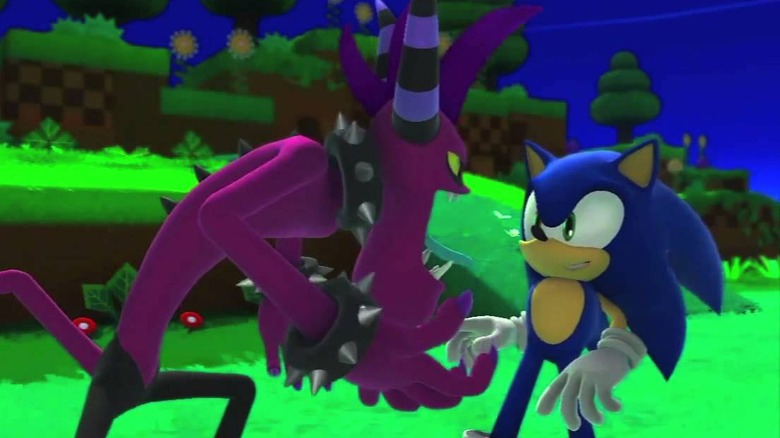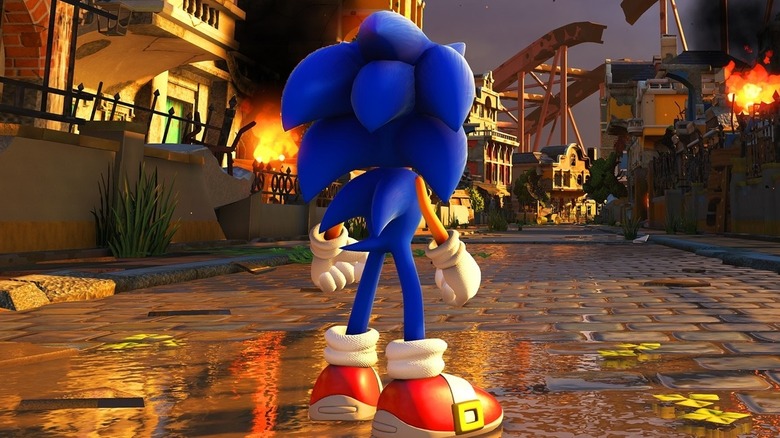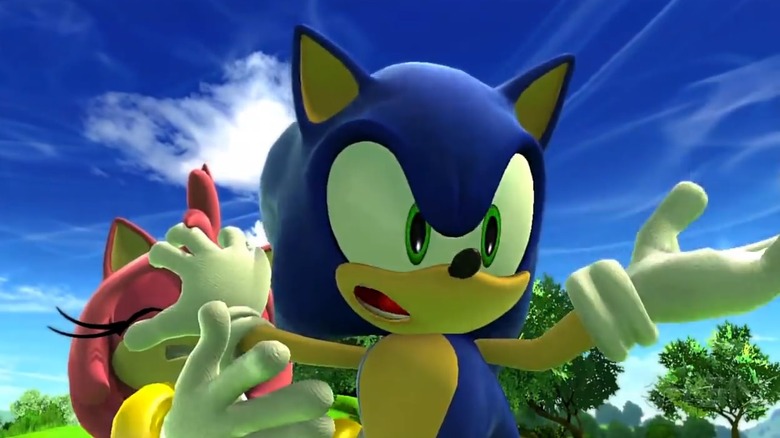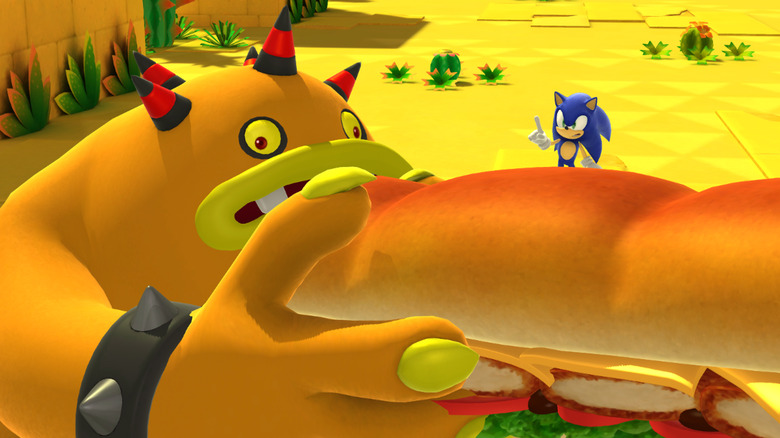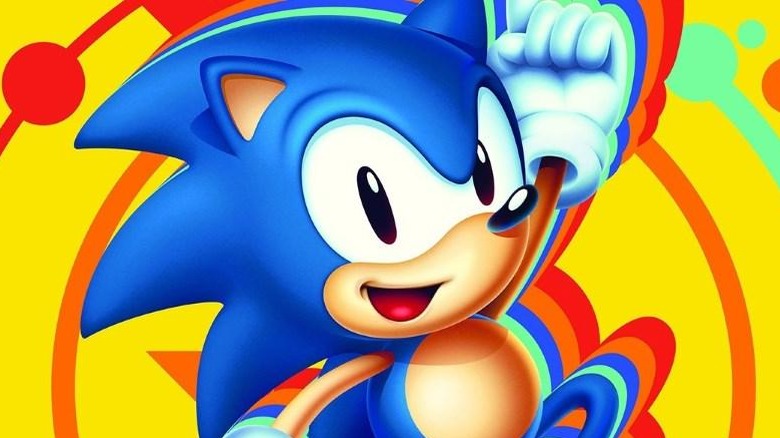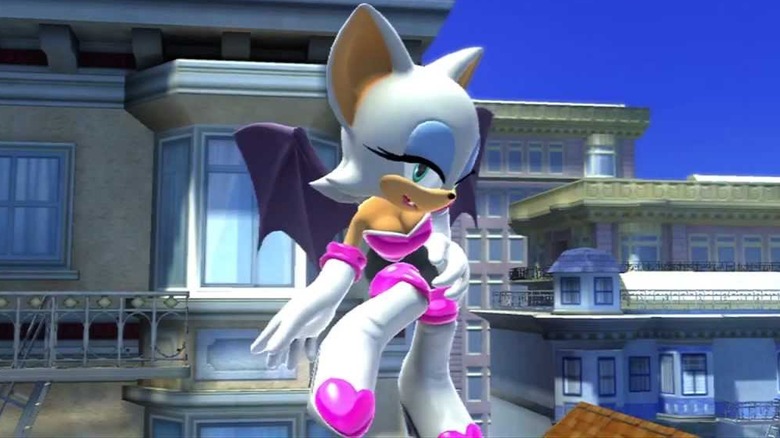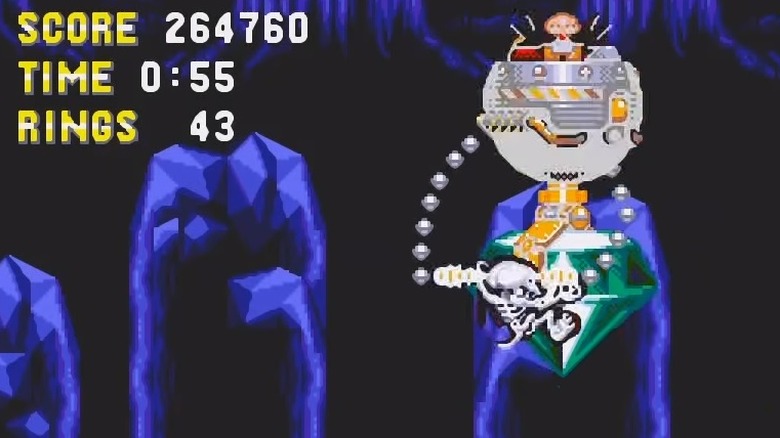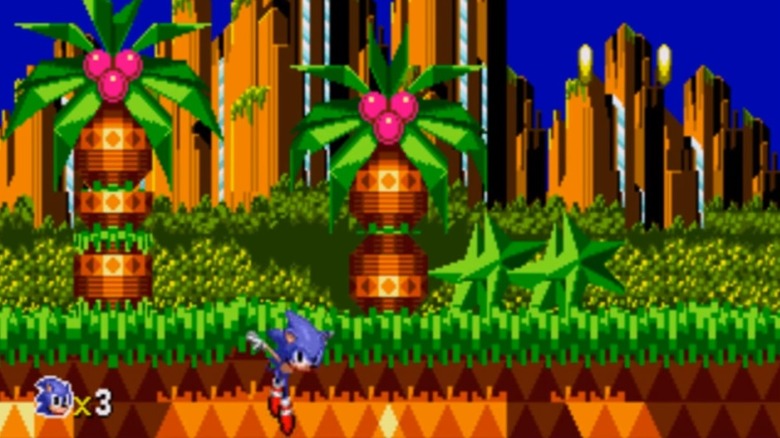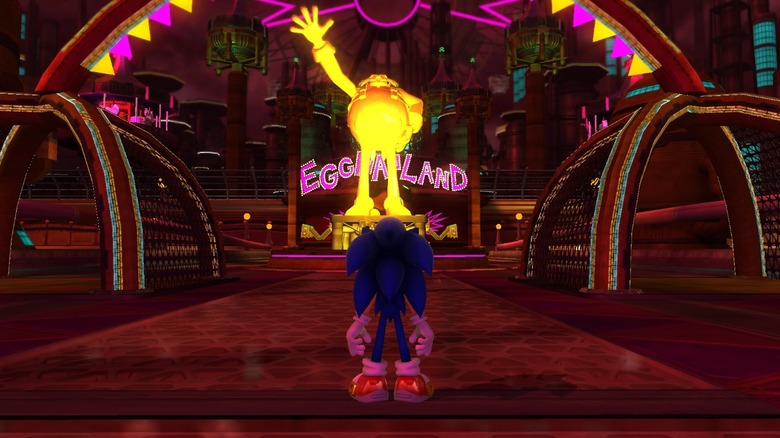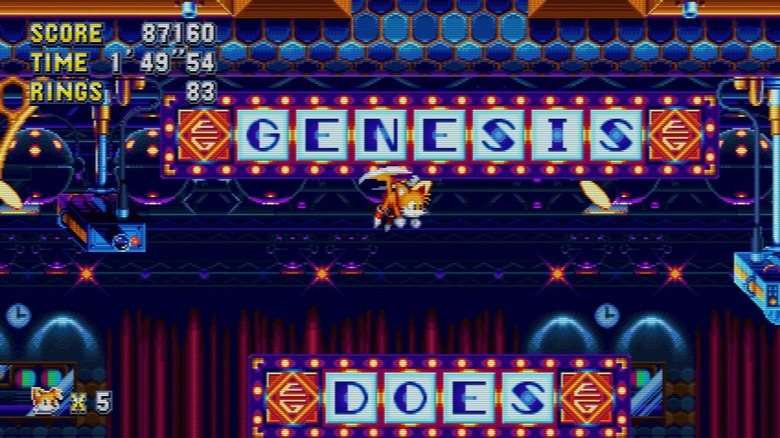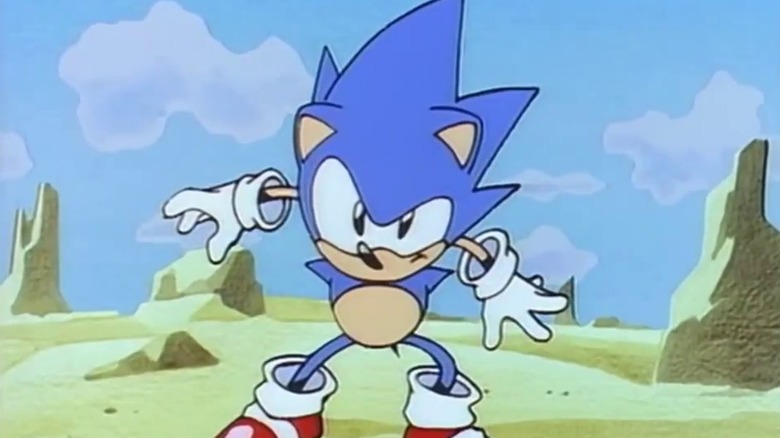Details In Sonic Games You Only Notice As An Adult
Sonic the Hedgehog is a game franchise founded on kid-friendly content, starring a hedgehog who exhibits youth-tailored snark and gameplay designed to keep audiences of all ages on the edge of their seats. But while the series' content might be appropriate for younger gamers ninety-nine-point-nine percent of the time, there's still the odd joke or narrative beat that will fly over kids' heads and smack their parents right in the face. This is because, believe it or not, there's some pretty unconventionally mature content nestled away within Sonic's vast library of games–stuff that's so understated you might not even catch it until you replay the titles as an adult. Be it over-sexualized anthropomorphic bats or Dr. Eggman's sociopathic tendencies, there's a lot to unpack in the Sonic the Hedgehog series when viewing with an adult pair of eyes.
The Zeti aren't just bad guys, they're serial killers
Sonic Lost World's group of villains are, on the surface, nothing more than a quirky set of punching bags for Sonic to dunk on. However, it only takes one close listen to their in-game dialogue to reveal a different story entirely.
Take, for example, Zazz. He's a spiky string-bean of a bad guy with the voice of an emo high-schooler. On the surface, that's just the profile of a run-of-the-mill Sonic bad guy. But midway through one of the first levels, his voice can be heard taunting Sonic, wherein he says: "You're going home in a box."
That's something a serial killer would say. While the wording is subtle enough that a kid might not think twice about the sentence, it's the kind of thing that'll make any adult pause and really assess the threat this villain poses. Clearly he doesn't just want to defeat Sonic, he wants to shatter every bone in the hedgehog's body...and then stuff them in a box. Zazz has some equally charming one-liners to match his opener, such as the ever-graceful "I'm going to skin you alive," and all of his bad guy pals share a similar propensity for death threats and hate speech. Case in point: The Deadly Six are a much more menacing set of villains than kids might process or SEGA will advertise.
Sonic never takes off his gloves or shoes in any of his games
Sonic the Hedgehog is a hero with no regard for modesty. That's why the only clothing he wears are his shoes and gloves. But set aside the fact that he's running around out there practically naked and there's still another problem with his minimalist wardrobe. The fact of the matter is, he's always wearing gloves and shoes, no matter what.
Does he ever change these two items for fresh pairs? Arguably not, as when one examines his shoes it becomes clear that they're accruing weathering with each new game's promotional art. That means those same sneakers are getting exponentially more worn down with every entry in the series, and those gloves are being torn apart fiber by fiber thanks to speed-induced wind weathering. And regardless of wear-and-tear, it's unhygienic to keep those same items on for so long. Think of the sweat build-up! With all those golden rings he collects, you'd think Sonic would've invested in a fresh set of clothing by now.
Of course, the biggest question this fashion oddity presents is the mystery of what his hands and feet look like. We can safely assume his hands are normal extensions of his arms, i.e. tan and five-fingered, but what about his feet? Does he have toes, or are they just big blue nubs? These are the mysteries that will continue to haunt us about Sonic's sneaker-and-glove combo.
Sonic is an emotionally abusive boyfriend
Sonic doesn't treat Amy Rose right. Whether it be abandonment, silencing of speech or risking her very life, Sonic continually treats her like a second-class hedgehog and never shows an inkling of remorse about it. But while the too-cool-for-the-ladies persona Sonic sports might help masquerade the true nature of this unsavory behavior, the reality is that he's just downright abusive.
Take the ending of Sonic CD, for example. Sonic drops off Amy in the middle of nowhere after rescuing her from the Death Egg, without stopping to see if she's okay or offering any further assistance whatsoever. He just ditches her. And remember the ending of Sonic Riders? Dr. Eggman uses Amy as a hostage shield, and instead of working out some way to save her beforehand, Sonic just dives in and writes her off as potential collateral damage. While she miraculously avoids injury during this dangerous move, Sonic's blatant lack of consideration for her safety is appalling. Then there's the time in Sonic Generations when she just wanted to wish Sonic a happy birthday–and he covered her face with his hand to silence her. All Amy wants to do throughout these games is love and dote on Sonic, and he continually puts her down in the most humiliating of ways.
Sonic Lost World has a PSA on chronic eating disorders
Sonic Lost World isn't just the last bastion of Zeti privilege in the Sonic the Hedgehog universe. It's also the home of the series' one-and-only PSA regarding the lethality of eating disorders and the accompanying steps to recovery. Not surprisingly, it's handled in such a way that only adults are going to catch the blink-and-you'll-miss-it nugget of content.
The game's most pudgy antagonist, Zomom, initially appears to be the laughing stock of the Deadly Six. He's overweight, obsessed with food and dumb as a brick, and the game plays off that for jokes. Until, that is, it stops being a joke, and Zomom has a moment of painful self-exploration.
It's a brief, fleeting sentence, but it's there nonetheless: amidst his lengthy ravings about food, he at one point stops and says, "I need an intervention." It's spoken with a sadness and sincerity that will resonate with anyone who's seriously struggled to overcome an addiction that's derailed their life, and acts as a shockingly somber bit of one-off dialogue to insert amidst the fat, yellow cartoon monster's string of goofy taunts. Hopefully Zomom gets the help he's so desperate for in a future Sonic game.
Sonic has one massive eyeball with two pupils
Ever take a close look at Sonic's eyes and notice that, well, there aren't actually two? Every time his brows lift ever-so-slightly in a cutscene, gameplay or promo art, it's revealed that he's got one massive eyeball that just happens to have two pupils. It's some pretty anatomically unnerving stuff. But beyond the unsettling appearance, what kind of health implications does this strange condition have for the heroic hedgehog? Well, one concern is that if he ever receives an injury to one of his "eyes," it'll technically be to both. Dr. Eggman might want to start targeting that massive peeper, then, since blinding it could be the singular key to defeating Sonic. Also, if Sonic has any genetic misgivings that might result in eye disorders or maladies, the consequences of such a condition would be doubly damning. To spell out the moral of this story: design your characters with two or more eyeballs, please. For their sake.
Dr. Eggman's robots are programmed to like animals to a weird degree
At first glance, Dr. Eggman's nefarious badniks seem coded solely to eradicate Sonic and friends. However, a certain mission in Sonic Generations reveals some...alternative programming in their system.
During one mission, Rouge the Bat is tasked with using her "wiles," as the game puts it, to distract badniks so that Sonic can attack them. She kicks off the mission saying, "that piece of junk robot is no match for my charms." The level consists of using Rouge to blow kisses at the killer machines to earn their romantic attentions.
There's no debate that it's a strange gimmick when taken simply at face value, but dwelling on it for just a little while longer reveals a far more sinister truth: evidently, the good doctor has programmed his badniks to be aroused by anthropomorphic animals. What utterly disgusting purpose might this function serve? The questions regarding Dr. Eggman's motives might take you farther down the rabbit hole than even he intended. And while we're on the subject of Rouge...
Rouge the Bat is ultra-sexualized
Kids aren't going to be privy to the strange undertones Rouge the Bat gives off, but adults are going to immediately notice how out of place she feels with the rest of the series' cast. She's the sole female in the Sonic games to wear a latex fetish outfit that exposes cleavage and remains the only character in the franchise's history to ever reference S&M. Her voice carries a deliberately sultry undertone unlike that of any of her fellow cast members and her appearances in games see her doing things like seducing robots, because apparently she's that attractive. All of it is very, very strange, especially when you consider the fact that the games never play up this aspect of her character for story purposes. This leaves us with no choice but to assume she exists exclusively as furry fan-service, courtesy of SEGA.
Dr. Eggman is obsessed with killing animals
While Dr. Eggman might be a one-dimensional kids' franchise character whose objectives are purely motivated by Bad Guy Logic™, that still doesn't explain the dark nature of his deeds. Think about it: he's a grown man with a genius-level IQ who spends all day creating contraptions with which to constrict, constrain, and kill animals. He shoves little woodland creatures into his robots to use their life energy as fuel and spends all of his time and effort trying to kill Sonic and friends, which means he's spending his days trying to slaughter hedgehogs, cats, foxes, and other sorts of adorable, furry creatures. Is that something a kid-friendly villain does? No, that's a mission held by a ruthless sociopath with no regard for the concept of wildlife protection.
This is a villain that preys on the weak animals that occupy the world around him, biding his time until he can once again take a stab at killing them when a new Sonic game rolls around. And when Eggman's even willing to go after Knuckles the Echidna, the last member of an entire species, it's just further evidence that this is a bad guy with problems that run way too deep for the child-friendly franchise he's a member of.
Sonic '06 has a princess that's attracted to dead animals
Sonic the Hedgehog, the 2006 game that nearly destroyed the character's reputation, is infamous for a lot of reasons. Tons of glitches, troublesome gameplay design choices, and a convoluted narrative are the most glaring issues when it comes to discussing this game's flaws. But more subtle problems lurk throughout–most notably its unsettling romantic elements. Rather than entertaining any sort of quasi-acceptable relationship prospects with Amy Rose, Sonic the Hedgehog instead decides to seduce a human princess. Princess Elise falls for the hedgehog's charms and, by the end of the game, they're smitten with each other.
This is why, when Sonic dies at the end of the game, Elise takes it upon herself to kiss his dead corpse in hopes of resurrecting him. It seems innocent enough on the surface, like a reverse Snow White story. But the reality of the situation is just a bit too strange. A human princess engaging in romantic activities with a dead animal-guy? Even if it's not taboo in the Sonic'06 universe, it's definitely an open invitation for all sorts of diseases–and frankly, just plain uncomfortable to watch.
Sonic might have ADHD
Sonic the Hedgehog isn't too cool for boredom, he's just mentally and physically incapable of coping with it. What does this mean, exactly? Well, it seems that everyone's favorite hedgehog is a serious contender for being diagnosed with ADHD. Seriously, he exhibits all the signs: a short attention span, hyperactivity, perpetual restlessness, lack of restraint, extreme impulsive behavior. Kids will think it's just part of his character's impatient attitude, but the older one gets the clearer it becomes that Sonic might not be practicing his "gotta go fast" mentality by choice. Remember Sonic CD? He was willing to jump off the screen and abandon his own game in order to avoid boredom, for crying out loud.
The Eggmanland long con
For anyone who completed the Xbox 360/PS3 version of 2008's Sonic Unleashed, there's one level they'll never forget: Eggmanland. This nearly hour-long gauntlet of punishment demanded the absolute best platforming and brawling skills a gamer could have, and made a name for itself as one of the hardest final stages in Sonic history. This level wasn't made so hard and lengthy just for kicks, however — there was a thematic reason for this level's intensity.
Eggmanland was the culmination of a construction plan that the villain had been plotting since Sonic Adventure, Sonic's 1998 Dreamcast console debut. That's right — Eggman had been working on Eggmanland for ten years, and only longtime Sonic fans who'd been with the franchise for all that time were privy to the payoff of such impressive foreshadowing.
The Eggmanland references in Sonic Adventure are straightforward, but you can miss them if you're not paying attention. First, Eggman explicitly mentions wanting to build Robotnikland. Given that Robotnik was Eggman's North American name at the time, some people might not realize this was the inception of the idea. Furthermore, the notorious 2008 level even features a direct callback to SA's Twinkle Park in the form of a flaming, purple-tracked rollercoaster, which serves as an in-universe point of reference for Eggman's design philosophies while constructing his city-sized doomsday amusement park. For longtime fans, these two little nods (and many others) can be seen as the payoff to a decade's worth of hype.
Genesis does
Though Sega's no longer in the hardware business, they once helped define it. Back in the 1990's, Sega was competing directly with Nintendo in the console market. The Sega Genesis was saddled with the tough task of beating out the NES and SNES, and the company hoped one catchy slogan would sway consumers to their side: "Genesis does what Nintendon't."
This snappy, snarky little phrase summarized Sega's almost monopoly-like grip on console rights to arcade titles, which used big names like Arnold Palmer and Michael Jackson to boost the profiles of games featuring the celebrities. Of course, the second Sonic the Hedgehog hit the scene in 1991, the "Genesis does" slogan took on a whole new meaning.
The decades-old marketing jab scored a neat little reference in 2017's Sonic Mania. In Studiopolis Act 2, you can hit some signs to reveal the phrase "Genesis does," reminding older gamers that Sonic and the team that created him never forget.
Toot Toot Sonic… Racing?
Long ago, in the distant past of 1993, Sega of Japan and Sega of America had such different visions for Sonic the Hedgehog that they couldn't settle on a single soundtrack for their flagship Sega CD game, Sonic CD. This resulted in two entirely different theme songs for the game. The North American version was "Sonic Boom," while the Japanese version was "You Can Do Anything."
For a long time, these songs remained exclusive to their respective regions. Fast-forward a couple decades, though, and now Sega has started to inject Sonic CD's Japanese soundtrack into North American releases of modern games, including 2019's Team Sonic Racing. This means the official soundtrack of Ocean View, a racetrack derived from a Sonic Heroes level, features a snappy remix of "You Can Do Anything," colloquially known in the Sonic fanbase as "Toot Toot Sonic Warrior" (which is a line from the song's lyrics). While new fans might not recognize the remixed tune, old-timers who've been with Sonic since the beginning and studied the differences in soundtracks will no doubt dig the tribute to one of the series' wildest region-exclusive theme songs.


